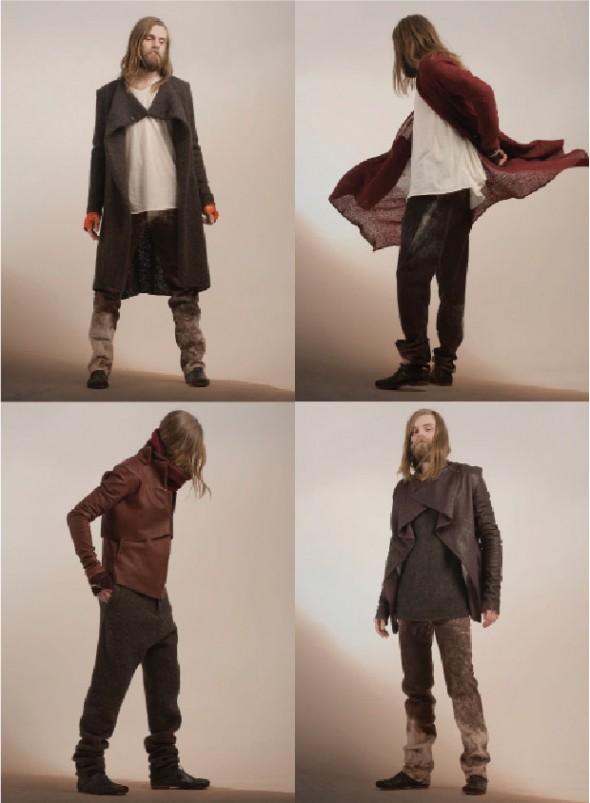
Draped, raw and digital – these are the three words describing designer Sruli Recht’s first venture into fashion as we know it, with his debut menswear collection presented in Paris last January.
A multi-faceted designer, Recht set up his design studio to work on cross-disciplinary projects. In 2008, he began producing a series of monthly ‘non-products,’ which garnered him worldwide fame and a significant amount of curiosity. Some of the most memorable pieces include a ‘travel mask’ that protects the wearer’s privacy presumably while traveling through the airports around the world, a polar bear rug with cartoonish features, a black diamond-tipped pen for tracing on glass, and a selection of idiosyncratic leather pieces, all produced using local materials and traditional techniques. Every product that comes out of Recht’s mind is pure innovation, interweaving childhood fantasy and a dark sense of humor.
He defines his Fall/Winter collection, titled When Gravity Fails, “a diagonal line for men.” Recht takes great pride in the fact that his collection is 98% Icelandic, collaborating with local tanneries, knitwear workshops and producers in order to ensure it. Furthermore, he devised a system called Macroscope, which allows him to create his pieces by ‘sketching’ fabric on a half-scale mannequin. With the aid of a camera trained on the form called the Macroscope, he captures the images of the half-scale garments, projecting them full-scale on a white wall. The silhouette is subsequently transferred onto paper and digitized, scaled-up and laser-cut onto fabric. The technique is used throughout the collection, drastically reducing the amount of time spent on production without losing any accuracy in the detailing. “What you have,” he explains, “is very little wastage of raw materials, much less time spent tracing and cutting, and much more time to work and think on your hands.” He describes the collection as a balance between construction and freedom, and, we add, with an incredibly well-executed combination of the raw and the digital.
A dramatically organic series, the materials range from hunted wild reindeer and stillborn lambskin to blackbird feathers, all combined to resemble a contemporary hunter’s attire. Conceptual yet strictly linked to a military, utilitarian aesthetic, overcoats which would be appealing to a unisex audience are made of natural materials in structured shapes. Accessories such as boots, bags and silver jewelry complement the line.
Poetical functionality and a constant curiosity for the design processes are the common threads in Recht’s work, and his second menswear collection, presented this past July, carries on the work he has been developing with material and shape. Focusing his attention to each detail, from the fabrics to the casing of each metal button, most garments of his new collection are created using one single piece of material draped to obtain the desired effect. The production, once again, is almost entirely Icelandic.
Sruli’s work is now collected at his first flagship store-cum-workshop, the Armoury (Vopnabúrið), in Reykjavik’s old fisheries, which he aptly baptized “The Fishpacking District.” He sells his ‘non-products’ and his collection, as well as paper products from artist Megan Herbert, in a big airy space furnished with reclaimed and discarded material from local businesses. The unique space, described as “a forum to experiment with new ideas,” truly reflects the designer’s forward-thinking perspective on life and design.
-Rosa Maria Bertoli

